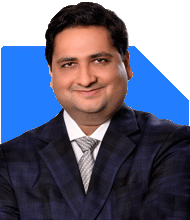Ramalingam Kalirajan |10893 Answers |Ask -Follow
Mutual Funds, Financial Planning Expert - Answered on May 29, 2024
He has an MBA in finance from the University of Madras and is a certified financial planner.
He is the director and chief financial planner at Holistic Investment, a Chennai-based firm that offers financial planning and wealth management advice.... more

Hi Sir, I am having following MF portfolio and Investment (Monthly) 1. ICICI PRU NIfty 50 Index Fund (2200) 2. CICI PRU NIfty Next 50 Index Fund (2200) 3. Parag parekh Flexi (4400) 4. HSBC Small Cap (1000) 5. Canara Robeco Small Cap( 4000) 6. HDFC Balanced Advantage Fund (4000). 7. Nippon Gold ETF (2000) 8. MON 100 (1000) .I want to increase my monthly investment by 25000-30000. Wanted to invest lumsum of 200000 in MF. Plz comment on Portfolio. Investment horizon 15-20 years. Wanted good corpus.
Your current portfolio is diverse and well-structured. It includes large-cap, mid-cap, small-cap, and balanced funds. This diversification reduces risk and enhances growth potential. Let's delve into each aspect of your portfolio and assess it critically.
Diversification and Balance
You have a good mix of equity and balanced funds. This provides a safety net against market volatility. The inclusion of small-cap funds adds growth potential, though they come with higher risk.
Equity Funds
Your portfolio includes large-cap and mid-cap equity funds. Large-cap funds offer stability, while mid-cap funds provide growth opportunities. The mix is well-balanced for long-term growth.
Balanced Funds
Balanced funds provide a mix of equity and debt. This combination offers moderate risk with decent returns. They are suitable for investors with a long-term horizon like yours.
Sector and Theme Funds
Investing in specific sectors or themes can be risky. They depend heavily on the performance of that sector. It’s wise to keep these investments to a minimum to avoid concentration risk.
Small-Cap Funds
Small-cap funds offer high growth potential but come with higher volatility. It’s good to have them in your portfolio, but they should not dominate your investments.
Evaluating Index Funds and ETFs
Disadvantages of Index Funds
Index funds have a passive management style. They mimic market indices and lack flexibility. They perform well only when the market is rising. In a downturn, they tend to perform poorly.
Benefits of Actively Managed Funds
Actively managed funds have professional fund managers. These managers can make strategic decisions based on market conditions. They can outperform the market and provide better returns.
Disadvantages of Direct Funds
Direct funds may seem cost-effective due to lower expense ratios. However, they lack professional advice and guidance. Investing through a Certified Financial Planner (CFP) provides valuable insights and tailored strategies.
Recommendations for Increasing Monthly Investment
Given your investment horizon of 15-20 years, you have the potential to build a significant corpus. Here’s how you can allocate an additional Rs 25,000-30,000 monthly:
Increase Allocation to Balanced Funds
Balanced funds provide stability and moderate returns. Increasing your investment in balanced funds can ensure steady growth.
Enhance Exposure to Large-Cap Funds
Large-cap funds offer stability and steady returns. They are less volatile compared to small-cap funds. Increasing allocation here can balance your portfolio.
Moderate Increase in Small-Cap Funds
Small-cap funds should still be part of your portfolio for growth. However, keep the exposure moderate to manage risk.
Consider Adding Mid-Cap Funds
Mid-cap funds offer a good balance between risk and return. Adding them can enhance your portfolio's growth potential without excessive risk.
Systematic Transfer Plans (STPs)
Utilize STPs to transfer a lump sum amount into equity funds gradually. This reduces the risk of market volatility and averages out the purchase cost.
Lump Sum Investment Strategy
Investing a lump sum of Rs 2,00,000 requires careful planning. Here’s a strategy to maximize returns:
Gradual Deployment Through STPs
Avoid investing the entire amount at once. Use STPs to move the lump sum into equity funds over 6-12 months. This approach mitigates market timing risk.
Diversify Across Asset Classes
Spread the lump sum across equity, balanced, and debt funds. This ensures a balanced risk-return profile and provides stability.
Focus on Actively Managed Funds
Choose actively managed funds for lump sum investments. These funds can adapt to market changes and aim for higher returns.
Regular Monitoring and Rebalancing
Regularly review and rebalance your portfolio. This ensures alignment with your investment goals and market conditions.
Conclusion
Your current portfolio is well-diversified and suitable for long-term growth. By increasing your monthly investment and carefully deploying the lump sum, you can build a substantial corpus over 15-20 years.
Remember to stay informed and make adjustments as needed. Consulting with a Certified Financial Planner (CFP) ensures you receive professional guidance tailored to your goals.
Best Regards,
K. Ramalingam, MBA, CFP,
Chief Financial Planner,
www.holisticinvestment.in
You may like to see similar questions and answers below
Omkeshwar Singh | Answer |Ask -Follow
Head, Rank MF - Answered on Oct 17, 2022
Hardik Parikh | Answer |Ask -Follow
Tax, Mutual Fund Expert - Answered on Apr 20, 2023
Dev Ashish | Answer |Ask -Follow
MF Expert, Financial Planner - Answered on Apr 26, 2023
Ramalingam Kalirajan |10893 Answers |Ask -Follow
Mutual Funds, Financial Planning Expert - Answered on Dec 15, 2025
Ramalingam Kalirajan |10893 Answers |Ask -Follow
Mutual Funds, Financial Planning Expert - Answered on Dec 15, 2025
Radheshyam Zanwar |6746 Answers |Ask -Follow
MHT-CET, IIT-JEE, NEET-UG Expert - Answered on Dec 15, 2025
Ramalingam Kalirajan |10893 Answers |Ask -Follow
Mutual Funds, Financial Planning Expert - Answered on Dec 15, 2025
Ramalingam Kalirajan |10893 Answers |Ask -Follow
Mutual Funds, Financial Planning Expert - Answered on Dec 15, 2025
Ramalingam Kalirajan |10893 Answers |Ask -Follow
Mutual Funds, Financial Planning Expert - Answered on Dec 15, 2025
Samraat Jadhav |2508 Answers |Ask -Follow
Stock Market Expert - Answered on Dec 15, 2025
Ramalingam Kalirajan |10893 Answers |Ask -Follow
Mutual Funds, Financial Planning Expert - Answered on Dec 15, 2025
Reetika Sharma |425 Answers |Ask -Follow
Financial Planner, MF and Insurance Expert - Answered on Dec 15, 2025
Radheshyam Zanwar |6746 Answers |Ask -Follow
MHT-CET, IIT-JEE, NEET-UG Expert - Answered on Dec 15, 2025

























